Access to Work Statistics: April 2007 to March 2020
Published 9 September 2020
Applies to England, Scotland and Wales
The latest release of these statistics can be found in the collection of Access to Work statistics.
Main stories
The key points from this release covering Access to Work in the financial year 2019 to 2020 are:
- Access to Work provision was approved for 39,060 people
- total expenditure on Access to Work was £141.7 million
- 43,400 people were in receipt of Access to Work payments
What is Access to Work?
Access to Work is a publicly funded employment support programme that aims to help more disabled people start or stay in work. There are 2 main types of Access to Work provision:
- ‘Assessments’
- ‘Elements’
Assessments involve exploring workplace-related barriers to employment and making recommendations on how these can be overcome. In some but not all cases the outcome of an Assessment may be to recommend the provision of one or more Elements. Elements are intended to supplement the reasonable adjustments that employers are required to make under the Equality Act 2010. The types of Element that can be provided are categorised as follows:
- Communication Support for Interviews
- Special Aids and Equipment
- Adaptations to Premises
- Adaptations to Vehicles
- Travel to Work (help with the costs of travelling to work)
- Travel in Work (help with the costs of work-related travel)
- Support Worker
- Mental Health Support Service
- Miscellaneous
In some but not all cases an Assessment is required to find out whether a customer is eligible to receive an Element.
What do these statistics show?
These statistics are about 2 specific parts of the Access to Work customer journey:
- the approval of Access to Work provision
- payment of Access to Work provision
They show:
- the number of people who had Access to Work provision approved
- the number of people who received at least one Access to Work payment
- Access to Work expenditure
These are disaggregated by various breakdowns including:
- financial year
- type of provision
- primary medical condition
- region
- age
- gender
The expenditure data in these statistics covers Department for Work and Pensions (DWP) expenditure only. In many cases, the employer will be asked to contribute to the cost of provision under “cost share” arrangements. The employer element of expenditure is not included in these statistics. We use this data to calculate statistics on the number of people in receipt of Access to Work payments in each year.
Although the Coronavirus (COVID-19) pandemic affected Great Britain in March 2020, this does not have a material effect on the 2019 to 2020 figures. Changes to Access to Work policy in response to COVID-19 came into force in the financial year 2020 to 2021. Read more information about: changes to Access to Work during the COVID-19 pandemic.
The Access to Work customer journey
The main stages of a typical Access to Work customer journey are summarised in the following table.
| Stage number | Stage name | Description |
|---|---|---|
| 1 | Application | The customer applies for Access to Work provision. |
| 2 | Approval or Rejection | DWP approves or rejects the provision after considering the customer’s eligibility and their employer’s duty to make reasonable adjustments under the Equality Act 2010. The customer is notified of the decision and a grant may be approved to cover some or all of the costs of the approved provision. |
| 3 | Commissioning | The customer or their employer commissions the approved provision and submits invoices relating to approved grants to DWP. |
| 4 | Receipt | The customer receives the approved and commissioned provision. |
| 5 | Payment | DWP pays the invoices relating to approved grants. In some cases a DWP payment is not required, for example because provision can be provided at no cost or the employer covers the relevant costs. |
| 6 | Review | DWP schedules reviews to ensure the provision is still adequate and to check that the customer is still eligible. |
Access to Work approvals in 2019 to 2020
The number of people who had any Access to Work provision of each type approved in 2019 to 2020
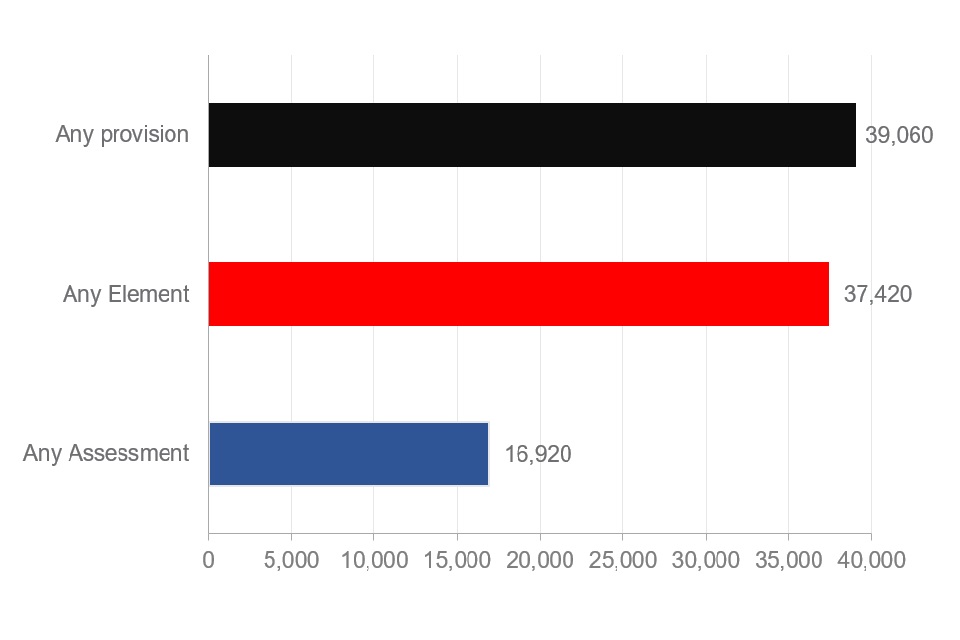
The key points are:
- of the 39,060 people who had an AtW provision approved in 2019 to 2020, 37,420 (96%) had an Element approved. The remaining 4% had one or more Assessments approved in 2019 to 2020 without any Elements approved in the same period. This may be because they had one or more Elements approved in a subsequent period or they did not require an Element or were not eligible for one
- 16,920 (43%) of those who had an AtW provision approved in 2019 to 2020 had an Assessment approved
- 15,280 people (39%) had at least one Assessment and at least one Element approved in 2019 to 2020
- 22,140 (57%) had an Element approved without an Assessment approved in the same period. This is because the corresponding Assessment was approved in a preceding period for example if the Element is a series of ongoing payments as seen with Travel to Work
Data relating to previous years can be found in Table 1 in the data tables accompanying this release.
The number of people who had any Element of each type approved in 2019 to 2020
Special Aids and Equipment Elements were approved for more people than any other type of Element.

The key points are:
- approximately 44% of the 37,420 people who had any Element approved in 2019/20 had one or more Special Aids and Equipment Elements approved in the same period
- the next most frequently approved Element types were Support Worker (39%), Mental Health Support Service (20%) and Travel to Work (19%)
- it should be noted that more than one Element of the same type or of different types can be approved for the same person in a given financial year
- it should also be noted that an approval for Access to Work does not necessarily result in a payment for Access to Work, a customer’s employer may pay for the support in full, or the customer may choose not to take up the support
Data relating to previous years can be found in Table 2 in the data tables accompanying this release.
Access to Work expenditure over time
Total nominal expenditure on Access to Work was £141.7 million in 2019 to 2020.
Expenditure on Access to Work provision 2009 to 2020 (nominal terms)
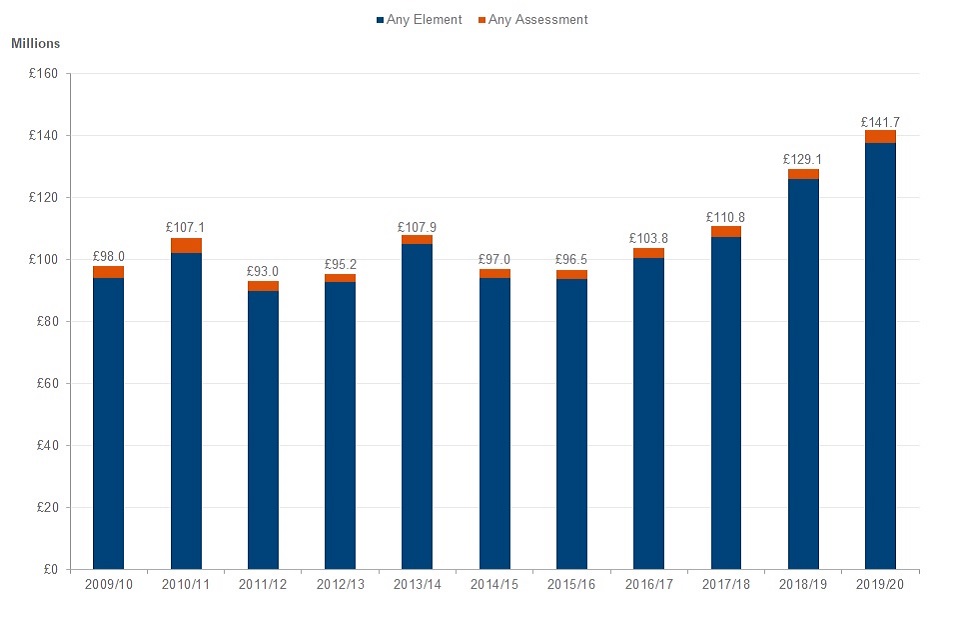
The key points are:
- total nominal expenditure on Access to Work provision has increased to £141.7 million in 2019 to 2020
- £137.5 million of this was expenditure on Elements
- the remaining £4.2 million was on Assessments
- Assessments account for around 3% of total expenditure. This proportion has remained steady over time
- nominal expenditure is the amount reflected on financial balance sheets. It does not account for inflation; therefore real terms expenditure should be used for year on year comparisons.
See Table 11 for full data, and Table 12 for expenditure on Elements of each type in the data tables accompanying this release.
Expenditure on Access to Work provision, 2009 to 2020 (real terms)
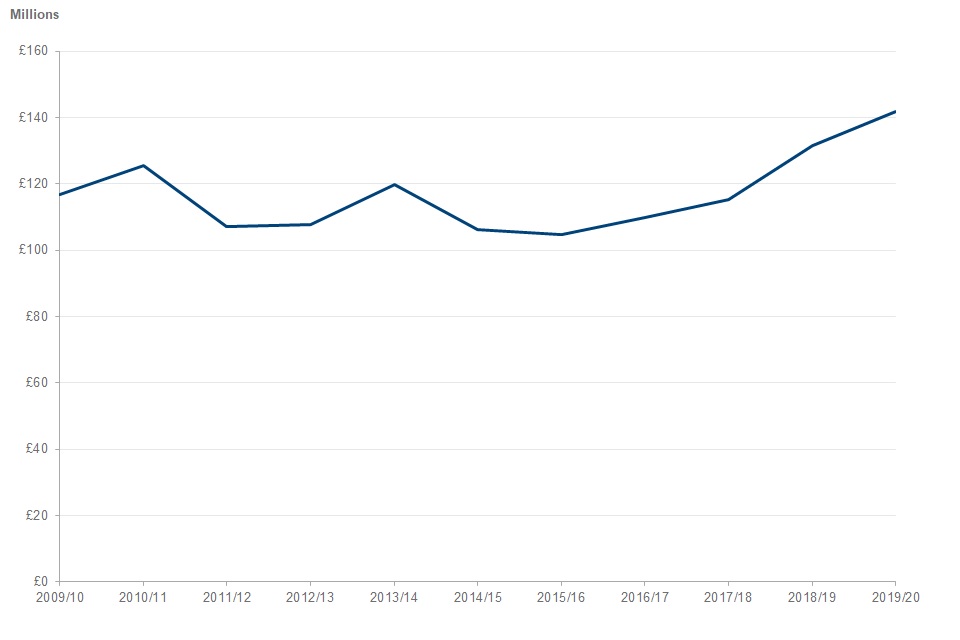
The key points are:
- real terms expenditure removes the effect of inflation to make year on year comparisons possible. Using 2019 to 2020 as the base year, real total expenditure has increased over the time period from 2009 to 2020
- real total expenditure was relatively steady during the period to 2015 to 2016
- since 2015 to 2016 real total expenditure has been increasing and has increased 8% comparing 2018/19 to 2019/20
See Table 11a in the data tables accompanying this release for more details.
More information
We use expenditure data from the Department for Work and Pensions’ Disability Service Client (DiSC) administrative system. This provides granularity (e.g. expenditure broken down by provision type), but we reweight this data to match the total Access to Work expenditure recorded through the department’s Single Operating Platform (SOP). SOP is the payment system used for much of the Department’s business. SOP provides a more reliable measure of spend than DiSC however the data cannot be disaggregated to the same level of detail as that in DiSC. Please see the accompanying background information and methodology note for more detail.
Number in receipt of payment of Access to Work over time
The number of people who were in receipt of one or more payments for any Access to Work provision of each type, 2009 to 2020
43,400 people were in receipt of Access to Work payments in 2019 to 2020
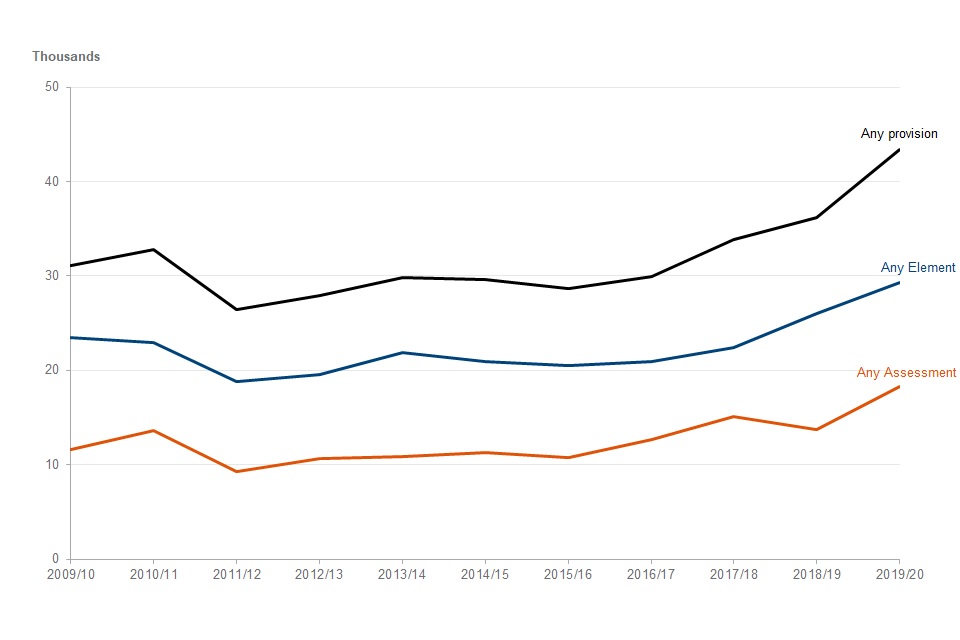
The key points are:
- of the 43,400 people who received a payment for Access to Work provision in 2019 to 2020, 29,280 (67%) received the payment for one or more Elements. The remaining 33% received a payment for an Assessment only, without receiving a payment for any Elements in the same period. This may be because they received a payment for one or more Elements in a subsequent period or they did not require an Element or were not eligible for one
- of those who received a payment for Access to Work provision in 2019 to 2020, 18,300 (42%) received a payment for one or more Assessments. The remaining 58% received a payment for an Element only, without receiving a payment for an Assessment. This may be where the customer received the assessment in a preceding period
See Table 6 in the data tables accompanying this release for full data.
The number of people who received a payment for any Access to Work Element of each type, 2009 to 2020
More people were in receipt of a payment for Support Workers than any other type of Element
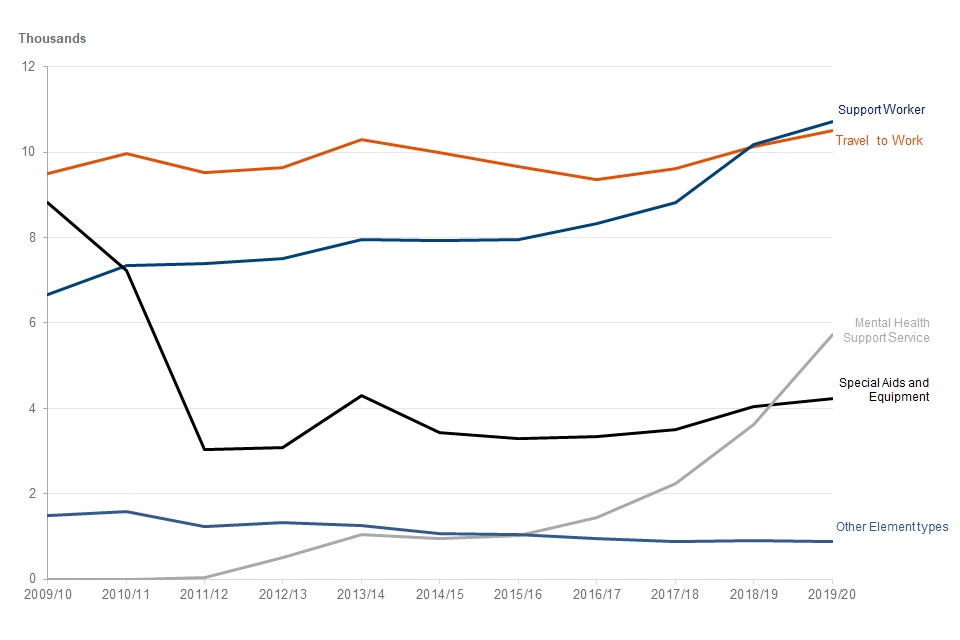
The key points are:
- 10,720 people received a payment for the Support Worker Element, which is the highest number of people for any Element
- prior to 2018 to 2019 Travel to Work was the element with the highest number of people in payment. Number of people who received payment for Travel to Work has been steady whereas number of people who receive payment for Support Workers has continued to grow
- the number of people who receive a payment for the Mental Health Support Service Element continues to increase, rising from 3,630 to 5,740, an increase of nearly 60% between 2018 and 2020
See Table 7 in the data tables accompanying this release for full data.
Characteristics of Access to Work customers in 2019 to 2020
The percentage of total expenditure and numbers in receipt of payment in 2019 to 2020 by primary medical condition
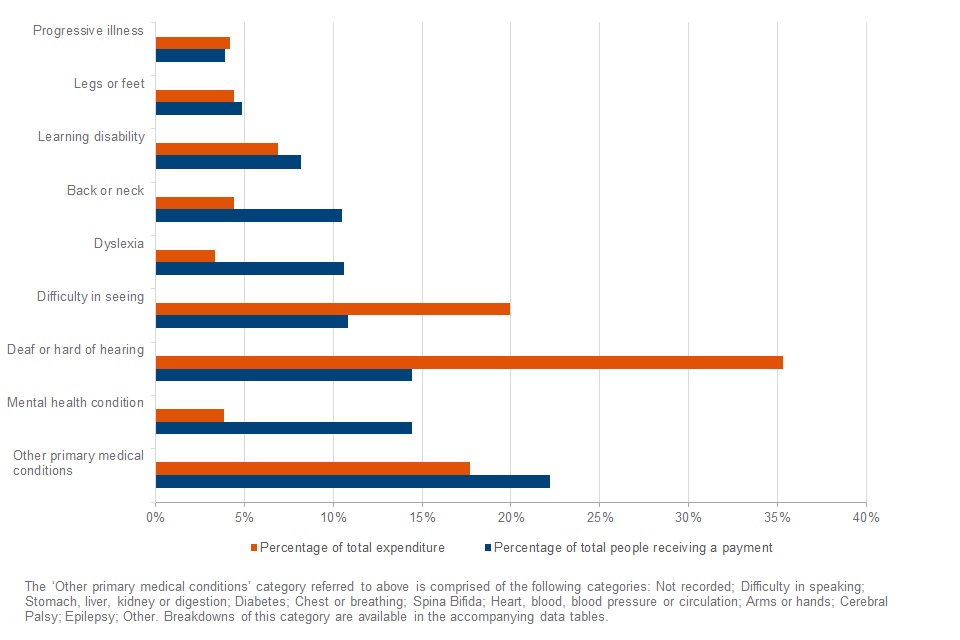
The key points are:
- the largest Access to Work customer group in terms of number of payments, by primary medical condition are those with a ‘Mental health condition’, who account for 14% (6,260) of the total number of customers closely follow by those with the primary medical condition ‘Deaf or hard of hearing’ (14% or 6,250 people)
- those who are ‘Deaf and hard of hearing’ are also in receipt of the highest proportion (35%) of total Access to Work expenditure
See Tables 8 and 13 in the data tables accompanying this release for full data.
The percentage of numbers in receipt of payment in 2019 to 2020 by age group
Access to Work continues to support young people as well as those customers who are older.

The key points are:
- the largest Access to Work customer group in terms of number of payments, by age are those aged 45 to 54 who account for 28% of the total number of customers
- people of all ages are in receipt of Access to Work support
See Table 8 in the data tables accompanying this release for full data.
Further information
These statistics have been developed using guidelines set out by the UK Statistics Authority and are new official statistics undergoing development. They have therefore been designated as experimental statistics.
We plan to publish these statistics on an annual basis and will explore the feasibility of expanding their scope to cover other parts of the Access to Work customer journey such as applications to Access to Work. Users are invited to comment on the development and relevance of these statistics at this stage and can send feedback to: access.toworkstatistics@dwp.gov.uk
These statistics were obtained from the Department for Work and Pensions’ Disability Service Client (DiSC) administrative system. DiSC is a live system and figures may be revised in future publications as records are amended or added to the system. More information about DiSC and revisions to these statistics can be found in the accompanying background information and methodology note.
Rounding
Figures in this publication are rounded to the nearest 10 people and nearest £1,000. Percentages are calculated using figures prior to rounding and are rounded to the nearest integer. Totals may not sum due to rounding or missing data.
Where to find out more
More information about these statistics can be found in the background information and methodology note and data tables accompanying this release.
Read more information about Access to Work, including how to apply.
Read Access to Work guidance for employers.
Read more information about [experimental statistics on the Office for National Statistics (ONS) website.
Next release
This publication is annual and the next release will be published in August or September 2021.
Contact details
For queries or feedback on this publication, contact: access.toworkstatistics@dwp.gov.uk
DWP Press Office queries, contact: 0203 267 5129
ISBN: 978-1-78659-272-9
